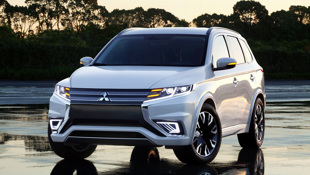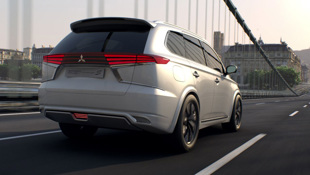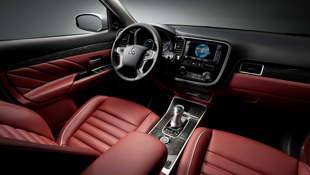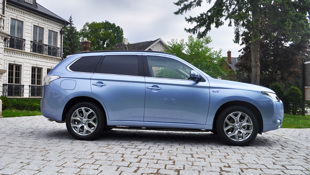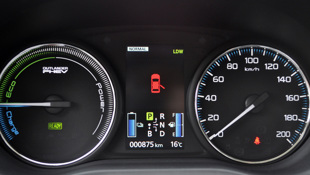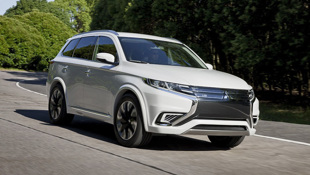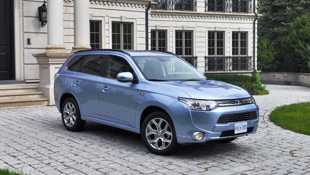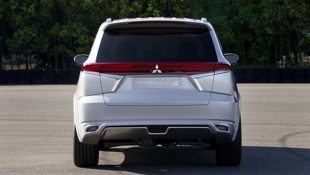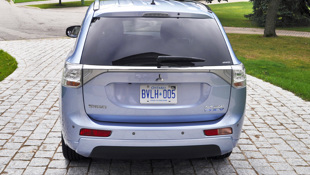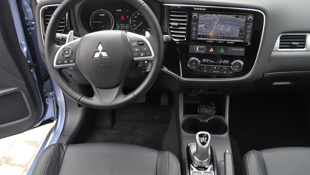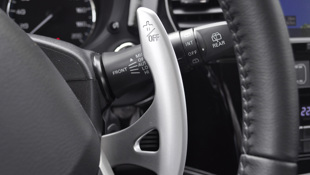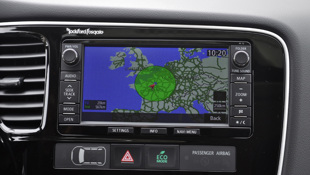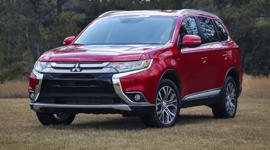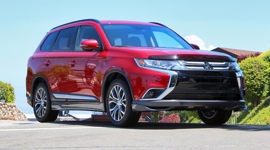The warning came fast and clear: this Mitsubishi Outlander plug-in hybrid we were about to sample is a current European model, while the one that’s scheduled for North America in 12 to 18 months will look very different from the one above. Even still, they’re close enough to what’s coming that Mitsubishi Canada went out and actually bought these two models to use for early dealer and internal technician training, as well as for demos for fleet sales. All for a vehicle not planned to arrive on Canadian shores until late 2015 or early 2016.
It’s very likely the most advanced vehicle Mitsubishi Motors has ever brought into Canada
Update: Between writing this review and time of publication Mitsubishi has released official photos of the Outlander PHEV Concept-S set to debut at the Paris auto show in early October, and it looks to be a clear indication of what the production version will look like when it lands on these shores. The Opel Ampera-like front end will take on an aggressive scowl with modern LED headlights and catfish-esque lower bumper treatment, with higher-end trim and finishes inside. Both interior and exterior upgrades appear ready for production models, though some toning down (aka cost-cutting) will likely tone down what becomes available at dealers, Mitsu saying somewhat cryptically that "it's a concept model presenting a special design package for the production Outlander PHEV.”
So why all this unusual attention and advance planning for a vehicle still so far away? Two reasons: 1) it’s very likely the most advanced vehicle Mitsubishi Motors has ever brought into Canada, with a large-for-a-PHEV 12-kWh lithium-ion battery, as well as a 2.0-litre internal combustion engine that takes over from the silent all-electric motor once the battery runs out of juice; 2) it has become the bestselling PHEV in Europe, and with growing sales for compact crossovers as well as plug-in hybrids in North America and Canada, it sees more sales and brand interest potential for the Outlander PHEV than for its slow-selling i-MiEV all-electric city car.
Depending on when the Outlander PHEV actually arrives – its North American launch has been delayed a couple times already – Mitsubishi Canada figures it will still be the first plug-in compact crossover on the market. That may come as news to buyers of the Ford C-Max Energi, the plug-in version of the C-Max Hybrid that has been on sale since 2012, and the Outlander PHEV’s likely main market rival.
But later to the party means it brings nicer gifts, as the Outlander PHEV will trump the Energi’s first-to-market but inherently compromised offering in two key areas: more all-electric range (up to a claimed 52 km versus an EPA-rated 30 km for the Ford), plus a much larger cargo area. Mitsubishi hides the plug-in electric components mostly under the vehicle, with just a touch higher floor than the gas model. That’s a major improvement compared to the C-Max Energi, which chops cargo room significantly from the already tighter cargo bay of the C-Max Hybrid.
The Mitsubishi also brings another unique plug-in party trick: it will be the first plug-in hybrid (so far) that can be fast-charged in about 30 minutes. Assuming you’re not pulling into the charging station on electron ‘fumes,’ it offers a nearly full charge (80 percent) in that half hour, using the same CHAdeMO fast-charging standard also used on the Nissan Leaf and Mitsu’s i-MiEV.
That quick-charging capability is not quite as critical in a plug-in hybrid as it would be in an all-electric vehicle, since the gas engine will automatically kick in to replenish the battery juice once grid power runs out, similar to the Chevrolet Volt. Also like the Volt, there’s a third mode in which the engine can connect to the front wheels directly to help pull the Outlander PHEV along. But unlike in the Volt, a hard stomp of the gas pedal with a full battery will trigger the four-cylinder engine, providing the driver with all 200 of its combined rated horsepower.
So how does this all come together on the road? As quietly as in a super-pricy luxury SUV, for the most part. Hit the Power button behind the steering wheel, and a high-tech phaser-worthy sound plus a lit-up dash tells the driver it’s ready to go, Star Trek–style. Differences from a regular Outlander interior include a main Eco/Power/Regeneration dial that indicates how quickly you’re using up your fuel, or nicely adding to it with braking, an extra battery ‘fuel’ level gauge right next to the traditional gas gauge, plus a more joystick-style shift lever in between the front seats.
There are even shift paddles behind the steering wheel, though the transmission is a one-speed transaxle, with no conventional transmission at all. So what’s the point? Like the pricier Cadillac ELR, the paddles adjust the ferocity of brake regeneration when you lift off the throttle, from a smooth sailing neutral-like zero position to an extreme, driving-in-second gear feel at level six, which allows for one-pedal driving that barely requires the brake pedal at all.
Some folks like this; BMW i3 drivers have no choice but to drive in this one-pedal fashion. Mitsu’s better and more flexible overall solution includes a default level-two setting with the shift paddles and a general ‘B’ mode for folks that want increased regeneration without playing with the paddles constantly. Plus it smooths out the ride for folks who just want to put it in D and forget it while still achieving spectacular fuel economy.
How spectacular? The overall European fuel economy figure is 1.9 L/100 km, which represents the fuel efficiency rating of exactly half of what a regular Toyota Prius achieves on the same optimistic NEDC cycle (3.8 L/100 km combined). To max out the fuel savings, Outlander PHEV owners will have to plug in at night, which in a 12-kWh battery will cost anywhere from 50 cents to a dollar a night for a full charge. The car can be plugged into a regular 110-volt outlet, which Mitsu estimates will take about 6.5 hours to charge fully, or in four hours with a level two charger, the kind of EV chargers sprouting up at malls, hotels, Tim Hortons and Canadian Tire locations around the country to attract customers.
Depending on how long your commute is, one could easily picture driving all week without using any gas, until you drive to grandma’s on the weekend with the family. And that commute can be improved with freer-flowing high occupancy traffic lanes in Ontario as well.
On the highway, it’s still largely silent, as the gas engine stays dormant until the driver exceeds 120 km/h, or asks for full power, say when merging on a short onramp. The engine is relatively quiet even when it comes on to power the generator that recharges the battery, which it can do fully with an empty battery using a button called Battery Charge mode – useful when you’ve done a long drive and depleted the battery, but want to drive in more efficient EV mode when you arrive in your destination city.
Sure, it’ll cost you more than the juice that came from plugging into the wall, but then finding the ideal balance is all part of the futuristic appeal of plug-in hybrid driving.
Disappointingly, the Outlander PHEV won’t be available in a three-row model, as it is with the gas-only model. This may cross it off the list of buyers who like the idea of a plug-in seven-seater, but outside of the pricey Tesla Model S and the even pricier upcoming Model X all-wheel-drive crossover, there’s no such beast, yet.
The all-wheel drive does come standard on the Outlander PHEV, courtesy of two 60-kW electric motors front and rear. There’s also Mitsubishi’s Super-AWC, just like the Evo and other Outlanders, so it’ll move power from side to side as well.
The downsides to these plug-in attributes? Price, as the Outlander PHEV costs about US$8,000 more than the diesel version in Europe, although Ontario and Quebec residents will be eligible for a major clean car rebate of about $7,000 on the Outlander PHEV, based on the size of its battery. Both provinces also offer $1,000 rebates on the price of the faster home L2 chargers as well. Yet access to even a regular outlet may be an issue for condo dwellers, or those without access to a garage, no matter where you live.
Like many hybrids, plug-in or otherwise, the brake pedal is a sensitive tool, which takes some time and experience to smooth out. But after a few untoward head bobs after setting out, the virtual silence of the driving experience provides an upscale feel that somewhat clashes with the Mitsu’s mainstream materials. Though our Euro tester’s navi system still thought we were on the continent, it still projected a large range map that showed how far the Outlander PHEV could go on the current tank and battery level.
All in all, it’s an impressive machine, and easily the most practical mainstream plug-in car yet available. Whether it retains that title by the time it finally arrives, how it will be priced, and how it will look, will be the key questions once it does finally arrive.
Pricing: 2016 Mitsubishi Outlander PHEV
Price as tested (est.): $43,000-$49,000

